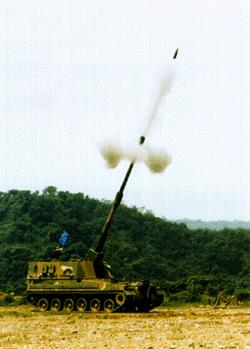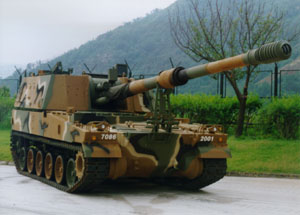



K9 155mm self-propelled howitzer
The new K9 howitzer, South Korean designed and developed, will give the Republic of Korea Army a significant improvement in capability over the current M109A2. With a claimed a range of 40 km, it offers greater mobility, longer range and higher rate of fire, and increased battlefield survivability as it can quickly be brought into action, open fire and come out of action. It is, therefore, less likely to be engaged by counterbattery fire. K9 is an indegenous system of an all-welded steel armour contruction which is rated to withstand impact by 14.5mm armour piercing shells and 152mm shell fragments. The main armament consists of a 155mm/52 caliber ordnance with a maximum firing range of 40km. State-of-the-art mobility subsystems include a 1,000 horsepower engine with potential for growth and hydropneumatic suspension unit.
The development program of this 155mm/52-caliber self-propelled howitzer has been underway since 1989. In 1996 the first prototype of this new artillery system was tested. The contract for the new K9 artillery system was awarded to Samsung Aerospace Industries (SSA) by the Korean Government on 22 December 1998. The contract, the South Korean Army received the first production batch of K9 from prime contractor SSA in 1999, making it the second country to deploy such a system.
SSA was also the prime contractor for local production of 155mm M109A2 self-propelled howitzer of which 1,040 were built under the co-production license with United Defense LP.
Licence production of the M109A2 was completed in 1997.
Program Milestones
| - Concept Formation & Exploratory Development |
July 1989 ~ July 1993 |
| - Full Scale Development(FSD), Phase I |
Oct. 1993 ~ Sept. 1996 |
- FSD, Phase II : Engineering & Manufacturing
Development(EMD) |
|
| * Prototypes Fabrication |
Oct. 1996 ~ Aug. 1997 |
| * Technical & Operational T&E |
Present from Oct. 1997 |
Primary Improvements in EMD
- Reliability
- Operational Capability
XK9 Performance Characteristics |
| Fire System |
To increase long range fire & rate of fire |
- 52 cal. barrel & new ammunition
- Automatic fire control system with INS
- Automatic gun laying systems
- Automatic shell handling & ramming systems
|
| Mobility |
To achieve rapid shoot & scoot |
- 1000 hp disel engine
- Hydraulic automatic transmission
- Hydraulic-pneumatic suspension
|
| Survivability |
To protect crew & system against ballistic |
- Optimal structure design for fragment protection
|


Sources and Methods
http://www.fas.org/man/dod-101/sys/land/row/k9.htm
Maintained by Robert Sherman
Originally created by John Pike
Updated Saturday, June 19, 1999 6:37:33 AM







